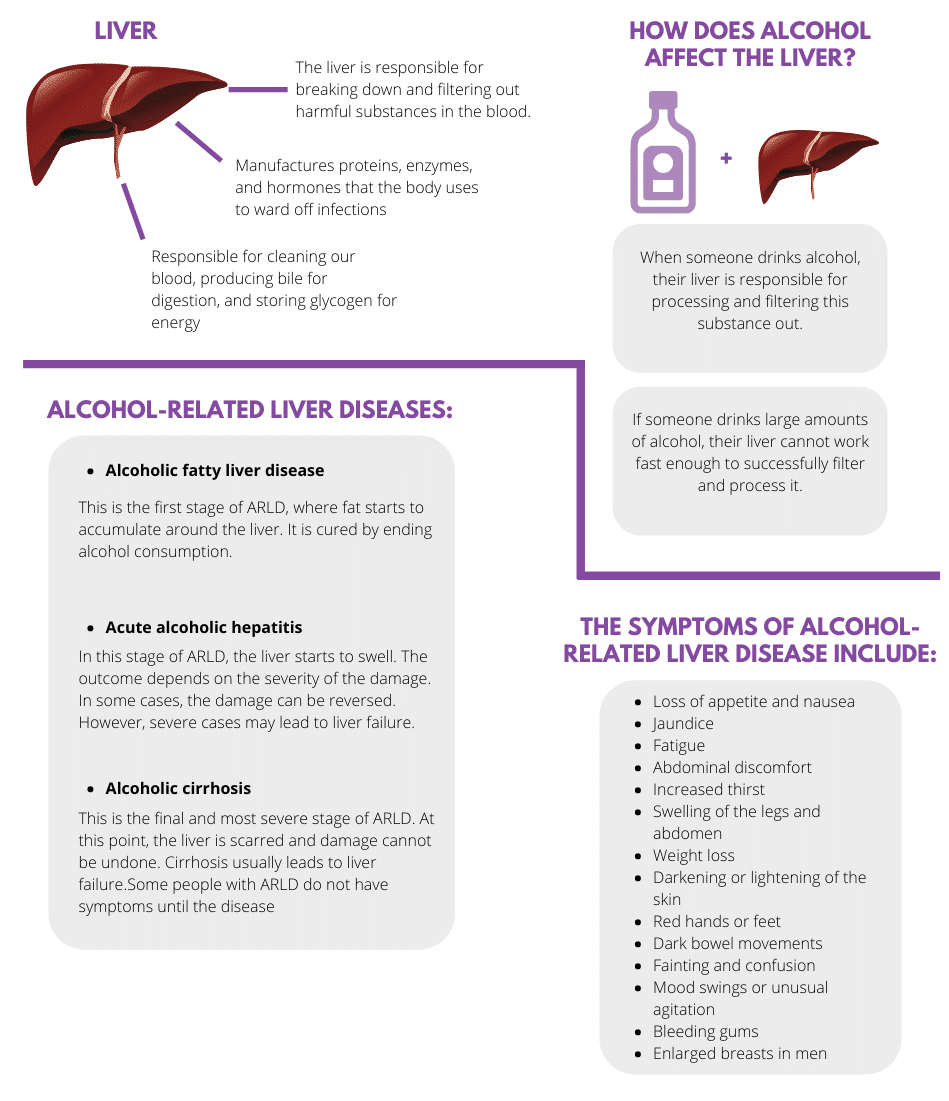Alcohol abuse is an increasingly concerning issue in America that continues to negatively impact people’s physical and mental health. For instance, the frequency of alcohol-related liver disease reported continues to increase. Even more concerning, a study conducted by the University of Michigan found that cirrhosis mortality related to alcohol use increases the most in people aged 25 to 34 years old. Alcohol-related liver disease is a serious issue that leads to serious and life-threatening consequences if left untreated.
Alcohol-related liver disease (ARLD) is caused by frequent and severe alcohol use that results in damage to the liver. After only a couple of years of drinking, the liver can become damaged and swollen. This damage eventually produces scarring known as cirrhosis of the liver, which is the final stage of liver disease. Although liver disease is only one of the severe consequences of alcohol abuse, it is especially serious because liver failure is potentially fatal. As a result, it is crucial to learn more about what ARLD is and how to prevent it from happening to you.

How Does Alcohol Affect the Liver?
The liver is responsible for breaking down and filtering out harmful substances in the blood. Additionally, it manufactures proteins, enzymes, and hormones that the body uses to ward off infections. Overall, the liver is responsible for cleaning our blood, producing bile for digestion, and storing glycogen for energy. All of these functions combined make the liver a vital organ for the body’s ability to run smoothly.
When someone drinks alcohol, their liver is responsible for processing and filtering this substance out. However, if someone drinks large amounts of alcohol, their liver cannot work fast enough to successfully filter and process it. As a result, the unprocessed alcohol circulates in the individual’s bloodstream. This is why alcohol is an intoxicating substance. Chronic alcohol abuse leads to the destruction of liver cells, resulting in scarring of the liver (cirrhosis), alcoholic hepatitis, and/or cellular mutation that ultimately results in liver cancer. While heavy drinkers may develop alcoholic cirrhosis without first developing hepatitis, it is common for these conditions to progress from fatty liver to alcoholic hepatitis, and then eventually cirrhosis.
Alcohol-Related Liver Disease: Types & Symptoms
There are three stages of alcohol-related liver disease. Additionally, each stage has a different set of symptoms to be wary of. If you catch the signs and symptoms of alcohol-related liver disease early, the treatment is usually successful. However, many people don’t realize that they are suffering from alcohol-related liver disease until it is too late. Therefore, if you suffer from an alcohol use disorder, it is extremely important to be knowledgeable about the early symptoms of liver disease.
The three stages of ARLD include:
- Alcoholic fatty liver disease: This is the first stage of ARLD, where fat starts to accumulate around the liver. It is cured by ending alcohol consumption.
- Acute alcoholic hepatitis: In this stage of ARLD, the liver starts to swell. The outcome depends on the severity of the damage. In some cases, the damage can be reversed. However, severe cases may lead to liver failure.
- Alcoholic cirrhosis: This is the final and most severe stage of ARLD. At this point, the liver is scarred and damage cannot be undone. Cirrhosis usually leads to liver failure.
Some people with ARLD do not have symptoms until the disease is advanced. On the other hand, other people may begin to notice signs earlier on. If you or a loved one suffer from alcohol addiction and have noticed some of the following symptoms, contact a medical professional as soon as possible.
The symptoms of alcohol-related liver disease include:
- Loss of appetite and nausea
- Jaundice
- Fatigue
- Abdominal discomfort
- Increased thirst
- Swelling of the legs and abdomen
- Weight loss
- Darkening or lightening of the skin
- Red hands or feet
- Dark bowel movements
- Fainting and confusion
- Mood swings or unusual agitation
- Bleeding gums
- Enlarged breasts in men
Additionally, symptoms of ARLD may show up more frequently or noticeably after binge drinking. People who have a family history of alcohol-related liver disease, drink frequently and heavily, binge drink, or have poor nutrition are more at risk for developing alcohol-related liver disease. Untreated ARLD can lead to irreversible damage to the liver, sometimes resulting in death. If you or a loved one are concerned about your alcohol consumption leading to liver disease, it is vital that you seek treatment from an alcohol detox immediately
Treatment for Alcoholism and Liver Disease
Alcohol-related liver disease treatment consists of two goals: treating alcoholism and improving liver health. If you are suffering from ARLD, the first recommendation is to go to an alcohol addiction treatment program to help you quit drinking. Furthermore, most treatment centers have the ability to either treat liver issues or connect you with someone who can. Typically, treatment of early alcohol-related liver disease consists of taking supplemental vitamins and ending alcohol consumption. More severe cases may require a liver transplant.
Many forms of liver disease are reversible if you attend alcohol rehab and receive medical attention. For example, fatty liver disease and alcoholic hepatitis are typically reversible through the abstinence of alcohol. However, cirrhosis and liver cancer are usually irreversible, as they are advanced forms of liver disease. If you struggle with alcoholism and symptoms of liver damage, it is vital that you seek out treatment for both issues. Call us today.







